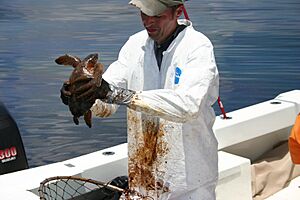Oil spill facts for kids
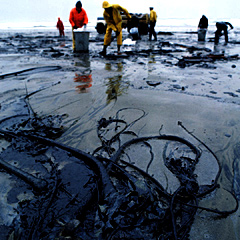
An oil spill happens when liquid petroleum (like crude oil) accidentally leaks into the environment. This is a type of pollution. Most often, we hear about oil spills in the ocean or near coasts. But they can also happen on land. Oil spills can come from tankers, offshore platforms, drilling rigs, and wells. They can also involve spills of gasoline, diesel fuel, or heavy fuels used by large ships. These spills cause serious harm to nature and the economy.
Oil gets into the plumage (feathers) of birds and the fur of mammals. This makes it harder for them to stay warm and float in water. Cleaning up an oil spill is very hard. It depends on the type of oil, water temperature, and the kind of beaches affected. Cleanup can take weeks, months, or even years.
Oil spills have terrible effects on people, nature, and money. Because of this, oil spills get a lot of attention. People often debate how governments should respond and how to stop them from happening.
Contents
How Oil Spills Affect People
Oil spills can quickly cause health problems for humans. These include breathing issues and other health problems. Spills also affect daily life. They can increase fire risks and close beaches, parks, and fishing areas. For example, the Kuwaiti oil fires caused air pollution that made people sick. The Deepwater Horizon accident caused many deaths among oil rig workers. The fire from the Lac-Mégantic derailment also caused many deaths and destroyed part of a town.
Spilled oil can also get into drinking water. In 2013, oil spills contaminated water for many people in Malaysia and Coca, Ecuador. In 2000, springs in Clark County, Kentucky were polluted by an oil spill.
Oil spills can also hurt local economies. They impact tourism and fishing businesses. For instance, the Deepwater Horizon spill harmed beach tourism and fishing along the Gulf Coast. Those responsible had to pay money to people who lost income.
How Oil Spills Harm Nature
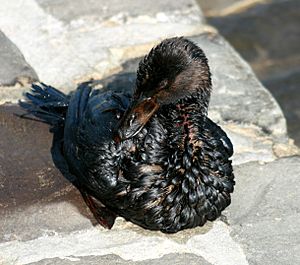

Impact on Animals
People have known since the 1920s that oil spills threaten birds, fish, and other sea creatures. Oil covers the feathers of birds and the fur of mammals. This stops them from staying warm and floating well in water.
Animals that use smell to find their young or mothers cannot do so because of the strong oil smell. This can lead to babies being left alone and starving. Oil can also stop birds from flying. This means they cannot find food or escape from danger. When birds try to clean their feathers, they might swallow oil. This can hurt their insides and and make them sick. Most oil-covered birds die without human help. Some studies show that very few oil-soaked birds survive, even after cleaning. However, in some cases, like the MV Treasure spill, many birds were saved.
Heavily furred marine mammals, like sea otters and seals, are harmed in similar ways. Oil on their fur makes them cold. Oil can also blind animals, leaving them helpless. Swallowing oil causes dehydration and digestive problems. Animals can be poisoned and die if oil gets into their lungs or liver.
Impact on Air Quality
Oil spills can also make the air unhealthy. Crude oil contains toxic chemicals like benzene and toluene. These chemicals can harm people if inhaled. When these chemicals evaporate, they can form tiny particles in the air. These particles can get into lungs and carry harmful chemicals into the body.
Burning oil on the surface can also create air pollution, like soot. During cleanup, ships can release pollutants like nitric oxides. Even bursting bubbles from the spill can create air particles. After the Deepwater Horizon oil spill, air quality was very poor along the Gulf Coast.
Impact on Ecosystems and Habitats
Most oil from a spill stays in the environment. Spills in the ocean are different from spills on land. Wetlands are very sensitive to oil spills and are hard to clean.
Where Oil Spills Come From
Oil spills can happen due to human mistakes, natural events, equipment problems, or even on purpose. About 30-50% of spills are linked to human error. Another 20-40% are due to equipment breaking down. Some of the biggest spills, like the Gulf War oil spill and Kuwaiti Oil Fires, were acts of war. Studying how and why spills happen helps us prevent them.
Natural Oil Leaks
About 40-50% of all oil in the oceans comes from natural leaks in the seafloor. This is about 600,000 tons each year worldwide. These natural leaks are less harmful because sea life has adapted to them. For example, ocean bacteria have learned to eat oil molecules in these areas.
Oil Tankers and Ships
Ships can cause oil spills in two ways. They can accidentally release oil, or they can improperly dump waste oil. Rules like the MARPOL convention try to stop improper dumping. These small, frequent spills are often not noticed as much. However, the amount of oil dumped this way has decreased a lot since the 1990s.
Accidents involving oil tankers caused about 8-13% of all oil spilled into oceans as of 2007. The main causes were collisions, running aground, mishandling, and sinking. Tanker spills are a big threat because they release huge amounts of oil. Also, many shipping routes are near important marine ecosystems. About 90% of the world's oil travels by tanker, and this amount is growing. But the number of spills from tankers and the amount of oil spilled per accident have gone down. In 1992, rules made it mandatory for large tankers to have double hulls (two layers of protection). This, along with GPS and better shipping lanes, has helped reduce spills.
In 2023, there was one large oil spill (over 700 tonnes) and nine medium spills (7 to 700 tonnes). These spills happened in different parts of the world and involved various types of oil. The total oil spilled in 2023 was about 2,000 tonnes. This continues a trend of fewer and smaller oil spills over the decades. For example, the 1970s had about 79 major spills per year. This dropped to about 6.3 per year in the 2010s and has stayed low. The total amount of oil lost has also decreased a lot. In the 1990s, over a million tonnes were lost. In the 2010s, this was down to 164,000 tonnes. In the early 2020s, about 28,000 tonnes have been lost.
Offshore Oil Platforms
Accidental spills from oil platforms now cause about 3% of ocean oil spills. Big platform spills often happen because of a blowout (when oil or gas rushes out of a well uncontrollably). These can leak oil for months until special relief wells are drilled. Examples include the Deepwater Horizon and Ixtoc I spills. Even though drilling technology has improved, companies are drilling in harder-to-reach places. This means there isn't a clear trend in how often platform spills happen.
Pipelines
Over the last forty years, there has been a big increase in pipeline oil spills. Famous examples include spills in the Niger Delta. Pipeline spills can be caused by fishing boats, natural disasters, pipe rust, construction flaws, or attacks.
Pipelines are thought to cause about 1% of ocean oil pollution. This number might be low because many pipeline leaks happen on land. Only a small part of that oil reaches the ocean.
Other Sources of Oil Spills
Recreational boats can spill small amounts of oil due to mistakes. These spills are often not reported.
Oil can also reach the oceans from land. Runoff from roads and rivers is estimated to cause 11% of ocean oil pollution. This includes oil from land vehicles washed into the sea by rain. Land-based spills are different because oil doesn't spread as fast on land. So, their effects usually stay local.
Cleaning Up Oil Spills
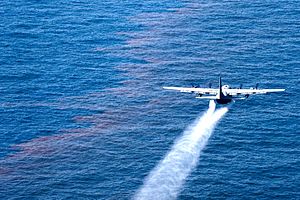
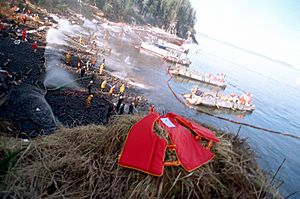
Cleaning up an oil spill is tough. It depends on the type of oil, water temperature, and the affected shorelines. Physical cleanups are also very costly. In the past, people used straw to soak up oil and then removed the straw by hand. Today, chemicals are often used. These chemicals can gather oil for removal, break it up in the water, or help burn it off. Future cleanup might use tiny organisms (microorganisms) that can eat oil.
There are different types of oil-eating bacteria. Some need air (aerobic), and some don't (anaerobic). These bacteria naturally help remove oil from nature. Products like Oil Spill Eater II have been used in many cleanups, removing a lot of oil.
Here are some ways to clean up oil spills:
- Bioremediation: Using tiny living things, like bacteria, to break down or remove oil.
- Bioremediation Accelerator: A special chemical that helps oil stick together and encourages natural oil-eating bacteria to grow. It makes oil easier to remove and helps bacteria break it down faster.
- Controlled Burning: Carefully burning the oil on the water can reduce its amount. But it needs low wind and can cause air pollution.
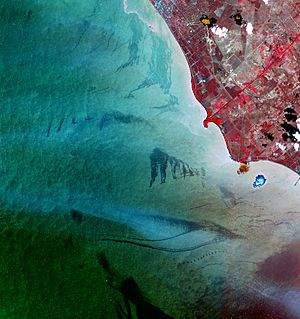
- Dispersants: These are chemicals that break up oil slicks into tiny droplets. This spreads the oil throughout the water. However, some studies show dispersants can make oil more toxic to fish and coral.
- Watch and Wait: Sometimes, letting nature clean up the oil on its own is best. This is especially true in sensitive areas like wetlands, where other methods might cause more harm.
- Dredging: Removing oil that has sunk to the bottom, often mixed with detergents.
- Skimming: Using special machines called skimmers to remove oil from the water surface. This works best in calm waters.
- Solidifying: Using special powders or pellets that turn liquid oil into a solid or rubber-like material. This solidified oil floats and is easier to collect. It can then be disposed of or even recycled.
- Vacuum and Centrifuge: Sucking up oil and water, then using a machine (centrifuge) to separate the oil from the water. The water is usually returned to the sea.
- Beach Raking: Using machines to pick up oil clumps left on beaches.

Equipment used includes:
- Booms: Large floating barriers that help contain and gather oil.
- Skimmers: Machines that collect oil from the water surface.
- Sorbents: Materials that absorb oil.
- Chemical and Biological Agents: Substances that help break down oil.
- Vacuums: Used to remove oil from beaches and water.
- Shovels and Road Equipment: Used for cleaning oil on beaches.
Preventing Oil Spills
- Secondary Containment: Building barriers to stop oil from spreading if there's a leak.
- Double-Hulling: Building ships with two layers of hull (outer and inner skin). This makes them safer in collisions or if they run aground.
- Thick-Hulled Railroad Tanks: Using stronger tanks for transporting oil by train.
Spill response plans should include:
- Safety gear and cleanup materials (gloves, masks).
- Evacuation plans.
- Firefighting equipment.
- Containers for waste.
- First aid procedures.
New Research for Cleanup
Scientists are looking at how "oil bees" collect flower oils. They are using this idea to create new materials that can remove oil from seawater. These materials have special hair-like parts that attract and hold oil.
Mapping Sensitive Areas for Oil Spills
Environmental Sensitivity Indexes (ESI) are tools that create maps called Environmental Sensitivity Maps (ESMs). These maps help us plan before an oil spill happens. They show sensitive areas and resources that need protection. This helps decide where to focus cleanup efforts. ESI is the most common mapping tool for this purpose. It looks at three main things: shoreline type, biological resources, and human-use resources.
How ESI Maps Developed
ESI was first used in 1979 after an oil spill in Texas. Back then, these maps were printed atlases with thousands of pages. They only worked for ocean spills. Over the last 30 years, ESI has become an online tool. In 1995, the US NOAA expanded ESI maps to include lakes, rivers, and estuaries. ESI maps now help gather and use data that was once hard to access. With GIS Mapping, ESI can accurately show where different resources are located.
Using ESI Maps
ESI maps show how strong an environment is against disasters and how it reacts to oil spills. They help experts make decisions about protecting sensitive areas, planning cleanup, and monitoring after a spill. These maps allow different experts to work together quickly during emergencies.
To make an ESI map, first, an area is chosen. Then, local experts meet to identify all shoreline types, plants, animals, and human-use areas. This information is then put into a digital format. Classifications are made, and local experts review the map before it is released.
ESI maps are mostly used for planning for emergencies. The most sensitive areas are identified and studied. Then, protection methods and resource assessments are developed. This detailed information is added back into the maps to make them more accurate.
ESI Categories
Shoreline Type
Shoreline types are ranked by how easy they are to clean, how long oil might stay, and how sensitive they are. A higher rank means a more sensitive habitat. Warm colors on maps often show more sensitive areas, while cool colors show tougher shores. This helps cleanup teams know which methods are safe for each area. Factors like wave energy, tides, and the type of sand or rock are considered. Mangroves and marshes often have high ranks because oil and cleanup efforts can cause long-lasting damage there. Exposed, rocky shores with strong waves are ranked lower. This is because waves can keep oil away, and natural processes clean them faster.
Biological Resources
This part of ESI maps shows protected areas and places important for many different kinds of life. These include plants and animals that could be harmed by oil spills. Animals are grouped by how vulnerable they are to oil. There are eight main groups: birds, reptiles, amphibians, fish, invertebrates, habitats and plants, wetlands, and marine and terrestrial mammals. These groups are further divided. For example, marine mammals include dolphins, manatees, pinnipeds (seals), polar bears, sea otters, and whales. When ranking species, experts look at how fragile they are, if many animals gather there, if important life stages (like nesting or migration) happen on shore, and if any species are rare or endangered. Symbols on the maps show species and their locations. These symbols can also show the most vulnerable times in an animal's life cycle, like molting or hatching. This helps create better response plans for those times. Underwater habitats like kelp forests and coral reefs are also mapped.
Human-Use Resources
These are places that people use and that would be affected by an oil spill. They are also called socio-economic features. These resources are divided into four main types: important historical or cultural sites, popular recreational areas (like beaches), protected management areas, and places where resources come from. Examples include airports, diving spots, marinas, hotels, factories, nature reserves, or marine sanctuaries. Local officials must approve which human-use resources need protection. These places can be very sensitive to seasonal changes, for example, due to fishing or tourism. Symbols on the maps show the importance of these human-use resources.
Estimating How Much Oil Spilled
We can estimate how much oil has spilled by looking at the thickness and appearance of the oil film on the water. If we also know the size of the spill, we can calculate the total amount of oil.
| Appearance | Film thickness | Quantity spread | |||
|---|---|---|---|---|---|
| inches | mm | nm | gal/sq mi | l/ha | |
| Barely visible | 0.0000015 | 0.000038 | 38 | 25 | 0.37 |
| Silvery sheen | 0.000003 | 0.000076 | 76 | 50 | 0.73 |
| First trace of color | 0.000006 | 0.00015 | 150 | 100 | 1.5 |
| Bright bands of color | 0.000012 | 0.0003 | 300 | 200 | 2.9 |
| Colors begin to dull | 0.00004 | 0.001 | 1000 | 666 | 9.7 |
| Colors are much darker | 0.00008 | 0.002 | 2000 | 1332 | 19.5 |
Oil spill models help experts plan and make decisions during emergencies. These models need good information about wind and water currents. There is a worldwide program for oil spill modeling (WOSM). Tracking a spill also involves checking if the oil collected comes from the current spill or another source. This uses special chemistry to "fingerprint" the oil based on its unique mix of chemicals, especially polyaromatic hydrocarbons.
Largest Oil Spills in History
Spills from tanker accidents have harmed sensitive ecosystems in places like Alaska, the Gulf of Mexico, and the Galapagos Islands. The amount of oil spilled can range from a few hundred to hundreds of thousands of tons. However, the amount of oil isn't the only measure of damage. Smaller spills, like the Exxon Valdez spill, had a huge impact because they happened in remote areas that were hard to reach for cleanup.
Oil spills in the Niger Delta are among the worst in the world. Between 1970 and 2000, there were over 7,000 spills there. From 1956 to 2006, up to 1.5 million tons of oil spilled in the Niger Delta.
Oil spills at sea are usually more damaging than those on land. This is because oil can spread for hundreds of miles in a thin slick. This slick can cover beaches and kill seabirds, mammals, shellfish, and other creatures. Land spills are easier to contain, and land animals can often avoid the oil more easily.
| Spill / Tanker | Location | Date | Tonnes of crude oil (thousands) |
Barrels (thousands) |
US Gallons (thousands) |
References |
|---|---|---|---|---|---|---|
| Kuwaiti Oil Fires | Kuwait | January 16, 1991 – November 6, 1991 | 136,000 | 1,000,000 | 42,000,000 | |
| Kuwaiti Oil Lakes | Kuwait | January 1991 – November 1991 | 3,409–6,818 | 25,000–50,000 | 1,050,000–2,100,000 | |
| Lakeview Gusher | Kern County, California, USA | March 14, 1910 – September 1911 | 1,200 | 9,000 | 378,000 | |
| Gulf War oil spill | Kuwait, Iraq, and the Persian Gulf | January 19, 1991 – January 28, 1991 | 818–1,091 | 6,000–8,000 | 252,000–336,000 | |
| Deepwater Horizon | United States, Gulf of Mexico | April 20, 2010 – July 15, 2010 | 560–585 | 4,100–4,900 | 189,000–231,000 | |
| Ixtoc I | Mexico, Gulf of Mexico | June 3, 1979 – March 23, 1980 | 454–480 | 3,329–3,520 | 139,818–147,840 | |
| Atlantic Empress / Aegean Captain | Trinidad and Tobago | July 19, 1979 | 287 | 2,105 | 88,396 | |
| Fergana Valley | Uzbekistan | March 2, 1992 | 285 | 2,090 | 87,780 | |
| Nowruz Field Platform | Iran, Persian Gulf | February 4, 1983 | 260 | 1,900 | 80,000 | |
| ABT Summer | Angola, 700 nmi (1,300 km; 810 mi) offshore | May 28, 1991 | 260 | 1,907 | 80,080 | |
| Castillo de Bellver | South Africa, Saldanha Bay | August 6, 1983 | 252 | 1,848 | 77,616 | |
| Amoco Cadiz | France, Brittany | March 16, 1978 | 223 | 1,635 | 68,684 | |
| Taylor Energy | United States, Gulf of Mexico | September 23, 2004 – Present | 210–490 | 1,500–3,500 | 63,000–147,000 | |
| Odyssey | off the coast of Nova Scotia, Canada | November 10, 1988 | 132 | 968 | 40,704 | |
| Torrey Canyon | England, Cornwall | March 18, 1967 | 119 | 872 | 36,635 |
The Economic Impact of Oil Spills
Oil spills cause terrible harm to nature. But they also have very bad effects on local and regional economies. These disasters hurt tourism, fishing, and port activities.
Decline in Tourism
An oil spill stops tourists from enjoying activities like swimming, boating, and fishing. This causes a drop in tourism. Hotels, restaurants, and shops nearby lose many customers. Travel agencies and tour guides are also affected. Beaches often close for days during cleanup. This can lead to businesses losing staff or even closing down.
For example, a spill of just 20 tonnes of oil in Ibiza in 2007 caused huge economic damage. Most beaches reopened within a week, and few animals were harmed. Yet, 27% of hotels were negatively affected. Tourist companies claimed about 1.5 million euros in compensation. After the Deepwater Horizon spill in 2010, the U.S. Travel Association estimated 23 billion dollars in costs for affected tourist areas.
Reduction in Fishing
After the Deepwater Horizon crisis, the Gulf of Mexico lost about 1.9 billion dollars in fishing income. Fishing was banned because people worried about seafood safety. Demand for seafood also dropped, forcing many restaurants and markets to close. The Gulf usually has many fishing trips each day, catching millions of pounds of fish. So, the fishing ban was very damaging.
Similarly, after the Prestige oil tanker sank near Spain in 2002, 77,000 tonnes of oil spilled. Fishing bans lasted over eight months. This hurt fishermen, boat owners, and fish sellers. About 113 million euros were spent to help those affected. These examples show how oil spills severely harm the fishing industry.
Oil pollution can kill or injure many sea creatures, including fish. Fish caught in a spill become tainted with oil and cannot be sold. If fish swallow oil, they are also unsafe for humans to eat. This greatly reduces the amount of fish available. Oil can also damage fishing boats and equipment. Cleanup operations and fishing bans can disrupt normal fishing routes. This is especially bad for regions that rely heavily on fishing.
Impact on Port Activity
Ports are important centers for trade and business. An oil spill in or near a port can have big consequences. During and after a spill, all boats entering or leaving the port must be carefully managed. Special cleaning crews must be hired to clean port structures. Small oil spills happen often in ports due to many boats. These are not always reported widely. However, they still need to be cleaned up and can cause economic problems.
Both the spill and the cleanup are expensive and take a lot of time. This disrupts port activities. Special care is needed to ensure oil does not get stuck under docks or sea defenses. If it does, it can cause ongoing pollution. So, ports must manage oil spills well to limit damage to ships and trade. Otherwise, major disruptions can lead to high cleanup costs and delayed shipments.
Summary of Economic Impacts
Oil spills have major economic effects on tourism, fishing, and ports. We need coordinated efforts to lessen these impacts. This includes effective cleanup, campaigns to improve the image of affected areas, and support for businesses and communities that suffer financially.
See also
 In Spanish: Derrame de petróleo para niños
In Spanish: Derrame de petróleo para niños
- Automated Data Inquiry for Oil Spills
- Environmental issues with petroleum
- Environmental issues with shipping
- LNG spill
- Storm oil
- Low-temperature thermal desorption
- National Oil and Hazardous Substances Pollution Contingency Plan
- Ohmsett (Oil and Hazardous Materials Simulated Environmental Test Tank)
- Oil Pollution Act of 1990 (in the US)
- Oil well
- Penguin sweater
- Project Deep Spill, the first intentional deepwater oil and gas spill
- Pseudomonas putida (used for degrading oil)
- S-200 (fertilizer)
- ShoreZone
- Spill containment
- Tarball


